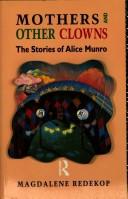| Listing 1 - 4 of 4 |
Sort by
|

ISBN: 0415010977 0415010985 9780415010986 Year: 1992 Publisher: London New Fetter Lane
Abstract | Keywords | Export | Availability | Bookmark
 Loading...
Loading...Choose an application
- Reference Manager
- EndNote
- RefWorks (Direct export to RefWorks)
Magic realism (Literature) --- Magisch realisme (Literatuur) --- Moeders in de literatuur --- Mothers in literature --- Mères dans littérature --- Réalisme magique (Littérature) --- 820 "19" MUNRO, ALICE --- Engelse literatuur--20e eeuw. Periode 1900-1999--MUNRO, ALICE --- Mothers in literature. --- Women and literature --- History --- 820 "19" MUNRO, ALICE Engelse literatuur--20e eeuw. Periode 1900-1999--MUNRO, ALICE --- Magic realism (Literature). --- Magical realism (Literature) --- Fantasy fiction --- Surrealism --- Magic in literature --- Marvelous, The, in literature --- Realism in literature --- Munro, Alice, --- Laidlaw, Alice Ann, --- מאנרו, אליס, --- מונרו, אליס, --- Criticism and interpretation. --- Munro, Alice --- Criticism and interpretation --- Munro, Alice Ann Laidlaw,
Book
ISBN: 0887558585 0887558593 9780887558580 9780887558597 9780887558573 9780887558818 0887558577 088755881X Year: 2020 Publisher: Winnipeg, Manitoba
Abstract | Keywords | Export | Availability | Bookmark
 Loading...
Loading...Choose an application
- Reference Manager
- EndNote
- RefWorks (Direct export to RefWorks)
"Making Believe responds to a remarkable flowering of art by Mennonites in Canada. After the publication of his first novel in 1962, Rudy Wiebe was the only identifiable Mennonite literary writer in the country. Beginning in the 1970s, the numbers grew rapidly and now include writers Patrick Friesen, Sandra Birdsell, Di Brandt, Sarah Klassen, Armin Wiebe, David Bergen, Miriam Toews, Carrie Snyder, Casey Plett, and many more. A similar renaissance is evident in the visual arts (including artists Gathie Falk, Wanda Koop, and Aganetha Dyck) and in music (including composers Randolph Peters, Carol Ann Weaver, and Stephanie Martin). Confronted with an embarrassment of riches that resist survey, Magdalene Redekop opts for the use of case studies to raise questions about Mennonites and art. Part criticism, part memoir, Making Believe argues that there is no such thing as Mennonite art. At the same time, her close engagement with individual works of art paradoxically leads Redekop to identify a Mennonite sensibility at play in the space where artists from many cultures interact. Constant questioning and commitment to community are part of the Mennonite dissenting tradition. Although these values come up against the legacy of radical Anabaptist hostility to art, Redekop argues that the Early Modern roots of a contemporary crisis of representation are shared by all artists. Making Believe posits a Spielraum or play space in which all artists are dissembling tricksters, but differences in how we play are inflected by where we come from. The close readings in this book insist on respect for difference at the same time as they invite readers to find common ground while making believe across cultures."--
Canadian literature --- Mennonite authors --- History and criticism. --- Mennonite art --- Music --- Mennonites --- History and criticism
Book
ISBN: 9780887558573 9780887558818 0887558577 088755881X Year: 2020 Publisher: Winnipeg University of Manitoba Press
Abstract | Keywords | Export | Availability | Bookmark
 Loading...
Loading...Choose an application
- Reference Manager
- EndNote
- RefWorks (Direct export to RefWorks)
"Making Believe responds to a remarkable flowering of art by Mennonites in Canada. After the publication of his first novel in 1962, Rudy Wiebe was the only identifiable Mennonite literary writer in the country. Beginning in the 1970s, the numbers grew rapidly and now include writers Patrick Friesen, Sandra Birdsell, Di Brandt, Sarah Klassen, Armin Wiebe, David Bergen, Miriam Toews, Carrie Snyder, Casey Plett, and many more. A similar renaissance is evident in the visual arts (including artists Gathie Falk, Wanda Koop, and Aganetha Dyck) and in music (including composers Randolph Peters, Carol Ann Weaver, and Stephanie Martin). Confronted with an embarrassment of riches that resist survey, Magdalene Redekop opts for the use of case studies to raise questions about Mennonites and art. Part criticism, part memoir, Making Believe argues that there is no such thing as Mennonite art. At the same time, her close engagement with individual works of art paradoxically leads Redekop to identify a Mennonite sensibility at play in the space where artists from many cultures interact. Constant questioning and commitment to community are part of the Mennonite dissenting tradition. Although these values come up against the legacy of radical Anabaptist hostility to art, Redekop argues that the Early Modern roots of a contemporary crisis of representation are shared by all artists. Making Believe posits a Spielraum or play space in which all artists are dissembling tricksters, but differences in how we play are inflected by where we come from. The close readings in this book insist on respect for difference at the same time as they invite readers to find common ground while making believe across cultures."--
Canadian literature --- Music --- Mennonites --- Mennonite authors --- History and criticism --- History and criticism
Book

ISBN: 9780271076584 Year: 2021 Publisher: University Park, PA
Abstract | Keywords | Export | Availability | Bookmark
 Loading...
Loading...Choose an application
- Reference Manager
- EndNote
- RefWorks (Direct export to RefWorks)
| Listing 1 - 4 of 4 |
Sort by
|

 Search
Search Feedback
Feedback About UniCat
About UniCat  Help
Help News
News